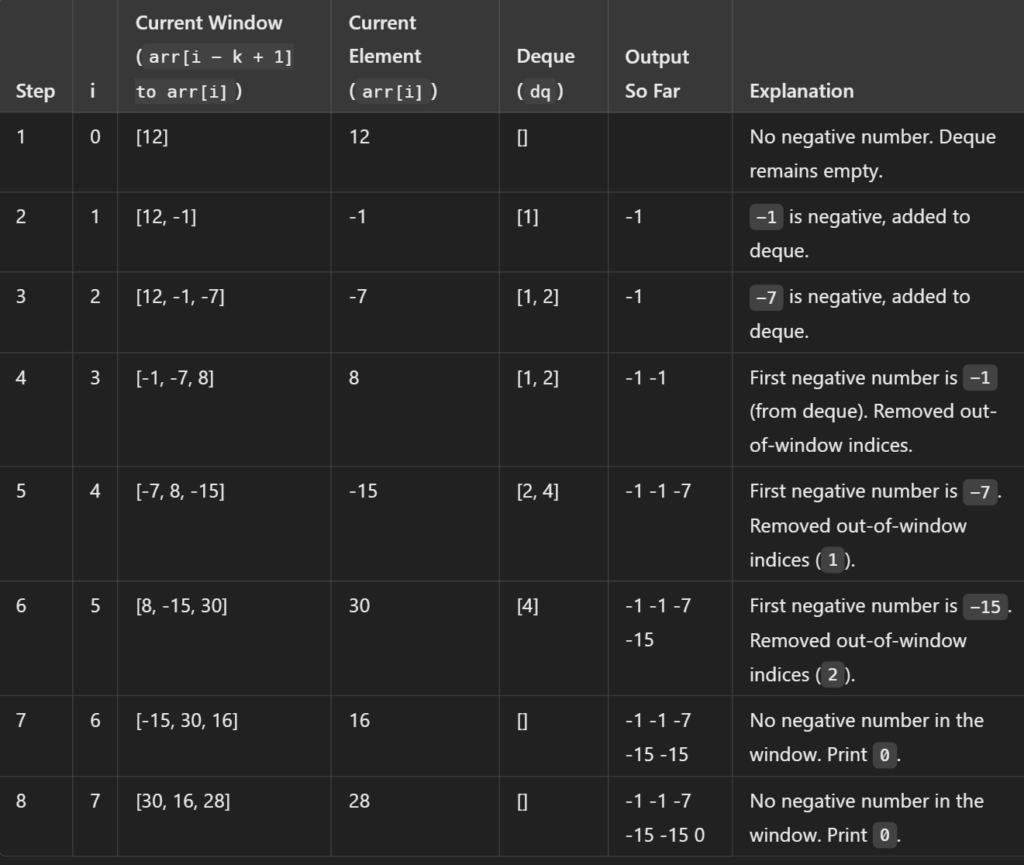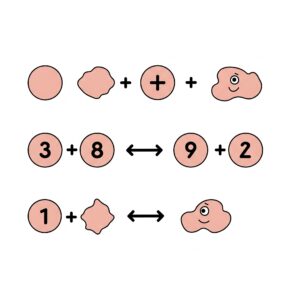To solve the problem of finding the first negative number in every window of size k in an array, we can use a sliding window approach. I’ll explain the brute force, better, and optimal approaches in C++, providing code along with a dry run for each.
Problem Statement:
Given an array arr[] and an integer k, find the first negative number in every window of size k. If there is no negative number in the window, print 0.
1. Brute Force Approach
In the brute force approach, we will loop through each window of size k and find the first negative number. This approach has a time complexity of O(n * k) because for each window of size k, we are scanning through the elements.
Code:
#include <iostream>
#include <vector>
#include <climits>
using namespace std;
void firstNegativeNumberBruteForce(vector<int>& arr, int k) {
int n = arr.size();
for (int i = 0; i <= n - k; i++) {
bool found = false;
for (int j = i; j < i + k; j++) {
if (arr[j] < 0) {
cout << arr[j] << " ";
found = true;
break; // exit as soon as we find the first negative number
}
}
if (!found) {
cout << "0 "; // No negative number in the window
}
}
cout << endl;
}
int main() {
vector<int> arr = {12, -1, -7, 8, -15, 30, 16, 28};
int k = 3;
firstNegativeNumberBruteForce(arr, k);
return 0;
}
Explanation:
- We iterate through each window of size
k. - For each window, we look for the first negative number.
- If no negative number is found, we print
0.
Dry Run:
For arr = [12, -1, -7, 8, -15, 30, 16, 28] and k = 3:
- Window 1: [12, -1, -7] → The first negative number is
-1. Print-1. - Window 2: [-1, -7, 8] → The first negative number is
-1. Print-1. - Window 3: [-7, 8, -15] → The first negative number is
-7. Print-7. - Window 4: [8, -15, 30] → The first negative number is
-15. Print-15. - Window 5: [-15, 30, 16] → The first negative number is
-15. Print-15. - Window 6: [30, 16, 28] → No negative number, so print
0.
Output:
-1 -1 -7 -15 -15 0
Time Complexity:
- O(n * k) where
nis the length of the array, andkis the window size.
2. Better Approach (Using a Queue)
In the better approach, we can optimize the brute force solution by using a queue to store the indices of negative numbers. This reduces the time complexity to O(n), as we are iterating through the array only once.
Explanation of Better Approach:
- We maintain a deque (
dq) to store indices of negative numbers. - For each new window, we:
- Remove elements from the front of the deque that are out of the current window.
- Add the current negative number to the deque.
- Output the first negative number in the deque or
0if there are no negative numbers.
class Solution {
public:
vector<int> FirstNegativeInteger(vector<int>& arr, int k) {
// write code here
deque<int>dq;
vector<int>ans;
int n = arr.size();
// Process the first window
for(int i = 0; i < k; i++) {
if(arr[i] < 0) dq.push_back(i);
}
// Add the result for the first window
if(!dq.empty()) ans.push_back(arr[dq.front()]);
else ans.push_back(0);
// Process the remaining windows
for(int i = k; i < n; i++) {
// Remove elements that are out of the current window
while(!dq.empty() && dq.front() <= i - k) dq.pop_front();
// Add the current element to the deque if it's negative
if(arr[i] < 0) dq.push_back(i);
// Add the result for the current window
if(!dq.empty()) ans.push_back(arr[dq.front()]);
else ans.push_back(0);
}
return ans;
}
};Dry Run Step-by-Step:
- Initialize the deque to store indices of negative numbers in the window.
- Process the first window (first
kelements) separately:- The first window contains the elements
[12, -1, -7](i.e., indices 0 to 2). - We iterate through the window and find the negative numbers.
- The first window contains the elements
- Start processing the rest of the array from index
kton-1.- For each new window, we:
- Print the first negative number from the deque.
- Remove indices that are out of the window.
- Add the current negative number (if any) to the deque.
- For each new window, we:
Dry Run for
arr = [12, -1, -7, 8, -15, 30, 16, 28] and k = 3:
- First Window: Indices 0 to 2 (
[12, -1, -7])- For indices 0 to 2, we check the negative numbers:
arr[0] = 12→ not negative.arr[1] = -1→ negative, so add index1to the deque.arr[2] = -7→ negative, so add index2to the deque.
- Now, the deque contains indices
[1, 2], pointing to-1and-7. - First negative number:
-1(because index1is the first in the deque). - Output so far:
-1
- For indices 0 to 2, we check the negative numbers:
- Window 2: Indices 1 to 3 (
[-1, -7, 8])- Remove indices that are out of the window:
1is still in the window, so we don’t remove it.2is still in the window, so we don’t remove it.
- Add the new element
arr[3] = 8, which is not negative. - The deque still contains indices
[1, 2]. - First negative number:
-1(because index1is still the first in the deque). - Output so far:
-1 -1
- Remove indices that are out of the window:
- Window 3: Indices 2 to 4 (
[-7, 8, -15])- Remove indices that are out of the window:
- Index
1is out of the window, so we remove it.
- Index
- The deque now contains
[2](pointing to-7). - Add the new element
arr[4] = -15, which is negative, so we add index4to the deque. - The deque now contains
[2, 4]. - First negative number:
-7(because index2is still the first in the deque). - Output so far:
-1 -1 -7
- Remove indices that are out of the window:
- Window 4: Indices 3 to 5 (
[8, -15, 30])- Remove indices that are out of the window:
- Index
2is out of the window, so we remove it.
- Index
- The deque now contains
[4](pointing to-15). - Add the new element
arr[5] = 30, which is not negative. - The deque still contains
[4]. - First negative number:
-15(because index4is still the first in the deque). - Output so far:
-1 -1 -7 -15
- Remove indices that are out of the window:
- Window 5: Indices 4 to 6 (
[-15, 30, 16])- Remove indices that are out of the window:
- Index
4is still in the window.
- Index
- The deque now contains
[4](pointing to-15). - Add the new element
arr[6] = 16, which is not negative. - The deque still contains
[4]. - First negative number:
-15(because index4is still the first in the deque). - Output so far:
-1 -1 -7 -15 -15
- Remove indices that are out of the window:
- Window 6: Indices 5 to 7 (
[30, 16, 28])- Remove indices that are out of the window:
- Index
4is out of the window, so we remove it.
- Index
- The deque is now empty.
- Add the new element
arr[7] = 28, which is not negative. - The deque is empty, so no negative number is found.
- First negative number:
0(since the deque is empty). - Output so far:
-1 -1 -7 -15 -15 0
- Remove indices that are out of the window:
Final Output:
-1 -1 -7 -15 -15 0Time Complexity:
- O(n), where
nis the length of the array.

Conclusion:
- Brute Force Approach: O(n * k) — Simply iterate over each window and find the first negative number.
- Better Approach: O(n) — Use a deque to keep track of negative numbers in the window, leading to a much faster solution.

